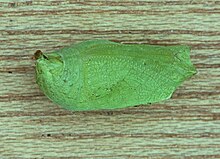Forest board game
| Forest board game | ||||||||||||
|---|---|---|---|---|---|---|---|---|---|---|---|---|

Forest board game ( Pararge aegeria ) |
||||||||||||
| Systematics | ||||||||||||
|
||||||||||||
| Scientific name | ||||||||||||
| Pararge aegeria | ||||||||||||
| ( Linnaeus , 1758) |
The forest board game ( Pararge aegeria ) is a butterfly (day butterfly ) of the subfamily of the ophthalmic butterfly ( Satyrinae) from the family of the noble butterfly (Nymphalidae). The specific epithet is derived from the name of the Roman spring nymph Egeria .
features
The moths reach a wingspan of 32 to 45 millimeters, the females are often slightly larger than the males. They have brown to dark brown wings with small, light yellowish-edged, black and white pithed eye spots . The spots are more evident in the females than in the males. On the forewing there is such a spot near the tip, which is flanked by several white spots arranged like a bandage. Three to four eye-spots sit next to each other on the hind wings. The outer edge of all wings is thin, interrupted white in color. The underside of the forewings is brown with numerous white spots and the same eye-spot as on the upper side. On the underside of the hind wings, instead of the eye-spots, dark brown, very faded and light-pithed spots can be seen. The basic color of the undersides of the hind wings is ocher and slightly marbled brown, with a purple sheen on the outer edge. There are also two thin, dark brown, wavy bandages on the hind wings.
The caterpillars are about 27 millimeters in size. Their body is yellowish green and has a white-edged, dark green stripe on the back. On the sides they have light and dark lines. The tail fork is whitish, the head bluish green.
Similar species
- Brown eye ( Lasiommata maera )
- Wall fox ( Lasiommata megera )
- Madeira forest board game ( Pararge xiphia )
- Canary forest board game ( Pararge xiphioides )
Subspecies
- Pararge aegeria tircis , distribution: France , British Isles , Switzerland , Fennoscandinavia , the Baltic States .
- Pararge aegeria aegeria , distribution: to be found in the south of Greece and in the European part of Turkey .
Occurrence
The moths occur in all of Central Europe and North Africa up to a height of 1,200 meters, with the subspecies P. aegeria tircis occurring in Central Europe , while P. aegeria aegeria is the southern variant. They live in riparian forests , mixed deciduous forests and dry forests , less often in coniferous forests. Light, warm, hardwood-rich forests are preferred.
Way of life
The male moths show a conspicuous territorial behavior. They sit in elevated positions from which they can observe their surroundings and try to drive away rivals that fly by. They keep returning to their seat. Forest board games rarely fly to blossoms, mostly they suck on sap and ripe fruit, but also on puddles.
Flight and caterpillar times
The moths fly in two generations from mid-April to early June and from July to mid-September. The caterpillars can be found from September to April of the following year and in June.
Food of the caterpillars
The forage plants of the caterpillars include various grasses such as B. Wood sedge ( Carex sylvatica ), giant fescue ( Festuca gigantea ), grove bluegrass ( Poa nemoralis ), woolly honeydew grass ( Holcus lanatus ), oat grass ( Arrhenatherum elatius ), pinnacle twinkle ( Brachypodium pinnatum ), pipegrass ( Molinia caerulea ) and sand riding grass ( Calamagrostis epigeios ). According to Ebert, the list of grasses is long, but no priorities have been found so far.
development
The females lay their eggs one by one on the stalks of the forage plants. The caterpillars hatch after about 10 days. The young animals are diurnal, but later they eat at night. In summer they take about 4 weeks to develop. The overwintering takes place either as a caterpillar or as a pupa . Pararge aegeria is the only butterfly that can also be found in the middle of an enclosed forest, provided there is a small, sunny spot.
swell
Individual evidence
- ^ Arnold Spuler: The butterflies of Europe . tape 1 . E. Schweitzerbartsche Verlagbuchhandlung, Stuttgart 1908, p. 49 .
- ↑ Heiko Bellmann : The new Kosmos butterfly guide. Butterflies, caterpillars and forage plants. Franckh-Kosmos, Stuttgart 2003, ISBN 3-440-09330-1 , p. 194.
- ^ Pararge aegeria. Butterflies-Deutschlands.de, Christian Tolasch, accessed on November 24, 2006 .
- ^ Günter Ebert: The butterflies of Baden-Württemberg. Volume 2: Tagfalter II. Ulmer Verlag, Stuttgart 1993. ISBN 3-8001-3459-4
literature
- Günter Ebert and Erwin Rennwald: The butterflies of Baden-Württemberg Volume 2: Tagfalter II , Verlag Eugen Ulmer, Stuttgart 1993 (correct reprint of the 1st edition), 534 pages, ISBN 3-8001-3459-4 .
- Tom Tolman and Richard Lewington: The butterflies of Europe and Northwest Africa , Franckh-Kosmos Verlags-GmbH & Co, Stuttgart 1998, ISBN 3-440-07573-7 .
- Hans-Josef Weidemann: Butterfly: observe, determine , Naturbuch-Verlag Augsburg 1995, ISBN 3-89440-115-X .
Web links
- Lepiforum e. V. Taxonomy and Photos
- www.schmetterling-raupe.de
- www.eurobutterflies.com (English)
- Moths and Butterflies of Europe and North Africa (English)
- www.natur-in-nrw.de
- Pararge aegeria at Fauna Europaea




